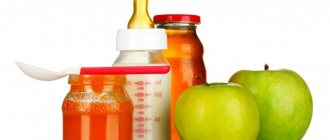Children who feed on breast milk for six months sooner or later become interested in food from the adult table. This is a signal that it is time to introduce complementary foods. Young mothers wonder where to start and how? To select the first product for a baby, his individual developmental characteristics, age, stool condition and the baby’s readiness for a new diet are taken into account.
Boy with a blue spoon
When to introduce complementary foods
Breast milk is considered the best nutrition for young children. Breasts are growing, and so are their needs for new nutrients. There comes a time when it is necessary to diversify the child’s diet with new products. When introducing complementary foods, it is recommended to focus on signs indicating the baby’s readiness and his individual developmental characteristics.
Signs of readiness for complementary feeding
The first parameter is the age of the baby. New foods are introduced while breastfeeding, starting at 6 months. Pediatricians recommend paying attention to a number of signs indicating that your baby is ready:
- The child is 6 months old. For premature babies, gestational age is considered.
- Since birth, the baby's weight has doubled.
- The first teeth have erupted.
- The child does not push out hard objects with his tongue: toys, spoon, bottle, drinking bowl.
- It is difficult for a baby to get enough of breast milk, despite the fact that it empties the entire breast.
- The baby is interested in different objects, holds them well in his hand and tries to taste them.
- When presenting a spoon, children open their mouths and stick out their lower lips.
- Shows interest in food products of adult family members.
The age norm for introducing new products is the period from 5 to 9 months. It all depends on individual developmental characteristics. There is no need to rush into this matter. The later they are allowed to try new foods, the easier they are absorbed by the child’s body.
Important! Twins and twins may be ready for complementary feeding at different times. No worries. If one child begins to try new foods at 6 months, the second may not start until 9 months. Over time, their diets will become equal.
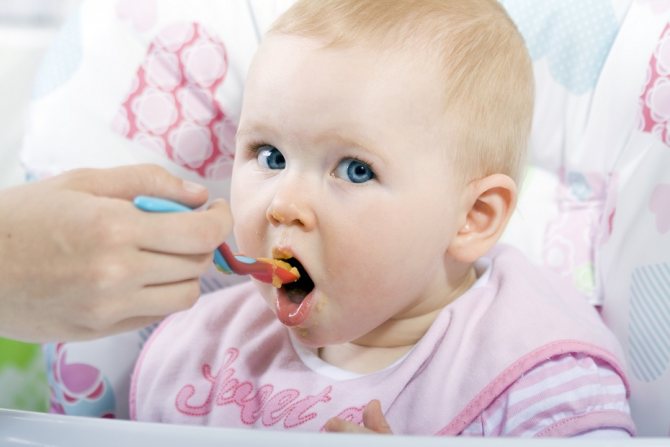
Child pulls a spoon
When to put off complementary foods
When visiting your pediatrician, your doctor may advise postponing the introduction of new foods. He establishes these conclusions by observing the baby’s development and after interviewing parents. Tolerate the introduction of complementary foods:
- with frequent allergic reactions of one of the parents;
- due to the presence of skin rashes on the child’s body;
- during a cold and fever;
- when is vaccination due?
- if the child sits poorly and holds his back.
Advantages of late introduction of complementary foods
Changing your baby's diet at a later age has its positive aspects. The older the baby, the stronger his body, and the better his digestive system is formed. The following advantages are noted:
- When fed only breast milk, the baby receives more protective antibodies.
- There is time for the digestive system to fully develop.
- The risk of allergies is reduced.
- This prevents the decrease in red blood cells and hemoglobin in the child’s body.
- Prevents the development of childhood obesity.
- The child is able to eat independently and does so with increased interest.
Complementary feeding during breastfeeding at 6 months
Menu for a 5-month-old bottle-fed baby
Young mothers who have decided to introduce complementary feeding are wondering what to start feeding a 6-month-old baby? Complementary feeding during breastfeeding starts with:
- vegetable puree;
- dairy-free porridge;
- fruit puree.
Important! Other products are allowed to be tried at a later age.
The first portion of a new product is given to try during the day to monitor the child’s reaction. It is 0.5 tsp. Then the baby is supplemented with breast milk. If no rashes were noticed on the baby’s body and there were no problems with stool, then the next day the portion is doubled. Every day add more product until the portion is 120-140 g.
Fresh puree is prepared for the new meal; it cannot be stored in the refrigerator. If the baby develops a rash or restless behavior, the introduction of complementary foods is canceled and a pediatrician is consulted.
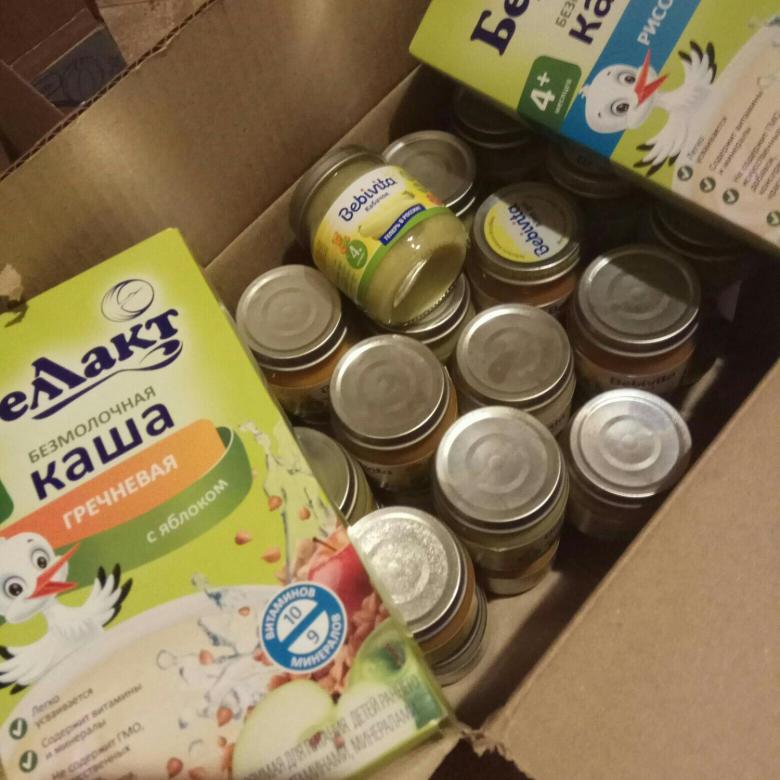
Baby food for first feeding
After introducing complementary foods, it is possible to create a menu for a 6-month-old breastfed child.
Instructions for introducing complementary foods with vegetable puree
| Weaning day | Amount of vegetable puree |
| 1 | 5 years |
| 2 | 10 g. |
| 3 | 20 |
| 4 | 40 g. |
| 5 | 80 |
| 6 | 120 g. |
| 7 | 150 g. |
| 8 | 5 g of a new vegetable can be mixed with the previous one |
| 9 | 10 g of a new vegetable is mixed with the first |
For your information. After each puree feeding, the baby is supplemented with breast milk. By the end of the week, one feeding is completely replaced with vegetables. Food for the child should be freshly prepared.
Recommendations for complementary feeding for 6-month-old artificial babies
Children receiving adapted milk formulas, in agreement with the pediatrician, begin to introduce complementary foods earlier - already at 4 or 5 months. By this age, the nutrients in formulas are no longer sufficient for the full development of the child’s body.
At 6 months, the baby is introduced to a second complementary food. If the child is already receiving vegetable and fruit purees, then dairy-free or dairy-free (depending on milk tolerance) porridge with added butter, juices, cottage cheese (adjusted to 20–30 g), and yolk are introduced. And if porridge was used as the first complementary food, then puree is introduced. Do not get carried away with semolina porridge, which contributes to the development of anemia and rickets.
Gradually the range of dishes is expanding. Children are given meat purees (turkey, veal), which can be prepared at home (by grinding boiled meat in a blender) or bought ready-made canned meat produced for baby food (paying attention to the expiration date).
Feeding is also recommended at 4-hour intervals. Snacking is not advisable to maintain appetite. Gradually, infant formula is being replaced by newly introduced products.
Rules for creating a menu at 6 months
Diarrhea in infants while breastfeeding
Drawing up a menu for a 6-month-old breastfed baby depends on his ability to gain weight, the nature of his stool, the time of year, and his state of health. There are several rules that are recommended to be followed when choosing products:
- When gaining weight slowly, dairy-free cereals are introduced first. Buckwheat, rice, and oatmeal porridge are suitable for this.
- Vegetable puree is bought in children's food stores. They are manufactured using special technologies and have a suitable consistency.
- When deciding to prepare vegetable puree, you choose vegetables that are typical for the season. In stores they buy zucchini, pumpkin, cauliflower and broccoli.
- The baby is given one product to try.
- If a child suffers from frequent gastrointestinal disorders, prune puree is preferred.
- Add 0.5 tsp to vegetable mixtures. vegetable oil. It improves digestion, improves baby's bowel habits and enriches the body with vitamin D.
- Melted butter is added to porridge to improve digestion and increase the calorie content of the dish.
- Meat and chicken broths are not given at an early age, as they cause additional stress on the kidneys.
- It is recommended to introduce vegetable purees immediately, then fruit purees, since after sweet foods the baby will not want to eat bland vegetables.
- Children's food is not added with salt; salt retains moisture in the body and puts a strain on the kidneys.
- Meat products, fish, whole milk and eggs are allowed to be tried after reaching one year of age.
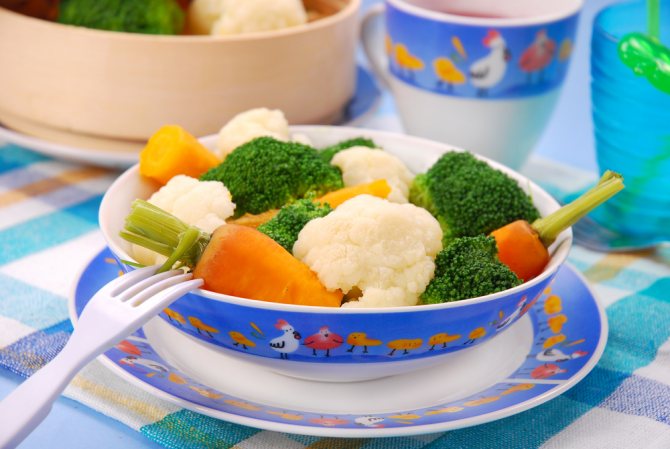
Products for first feeding
How to diversify the children's menu
How much should a 6 month old baby sleep?
The age of six months marks a significant expansion of the child’s diet. Previously, it contained formula or milk. Now the baby, to some extent, joins the world of adults. Parents must understand that they cannot simply take any vegetable and give it to their baby. For the first complementary foods, the most hypoallergenic products are selected:
- Among vegetables, these are the Big Five, as mothers jokingly call them: zucchini, broccoli, cauliflower, pumpkin, carrots.
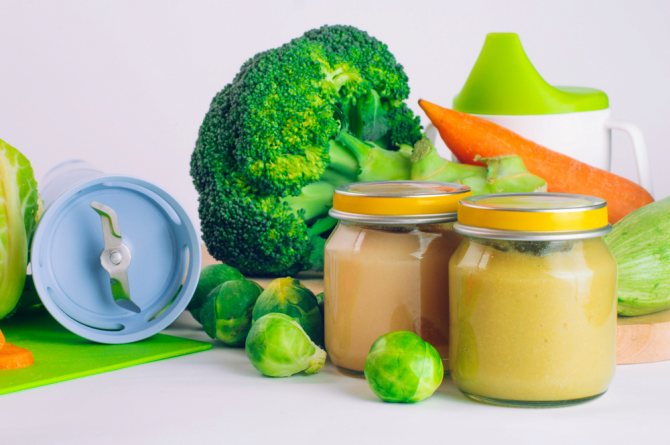
Vegetables for first feeding
Important! When introducing a one-time volume of vegetables into a child’s diet of 75 grams. you need to start adding cold-pressed olive oil to the puree at the rate of 1 tsp. for a full portion (150-180 g).
- From porridges (strictly dairy-free) - corn, buckwheat, rice.
- It is not recommended to introduce fruits first. It is believed that the child will get used to the sweet taste and then refuse vegetables that are not so tasty. There are no strict contraindications. If the mother decides to give the baby a fruit, then let it be an apple or a banana.
- By six months, you can introduce egg yolk into your baby’s diet. Giving it more than three times a week is unacceptable. Protein is not given to toddlers; it is a strong allergen.
- If you want to pamper your child, it is permissible to give him a baby cookie to try (you need to take into account the age label and treat it responsibly) or a regular cookie.
If your baby doesn’t want to eat porridge, you can try making it with the mixture, if it was previously introduced into the diet. As a rule, this helps to avoid whims, and the baby will calmly eat his portion.
Note! A breastfed baby does not require supplemental feeding, except in hot weather. With the start of complementary feeding, even if it is one spoonful of vegetables, water must be given.

Baby needs water
A 6-month-old toddler is learning about different drinks:
- You can start giving him juices, but only diluted with water. Take two parts clean water and one part juice: apple, pear. This is not recommended if your child has problems with bloating. Juices should be introduced into the diet at least two weeks before fruit purees.
- From 4 months, babies are allowed to drink weak decoctions of fennel, lemon balm, mint, and even more so by 6 months. You can buy regular herbs in bulk, or mixtures in filter bags. For busy parents, baby food manufacturers have released granulated herbal teas moderately sweetened with dextrose. Such products are produced by Hipp, Bebivita.
The main variety on the children's table is the new products themselves. The baby should eat them in puree to avoid suffocation (the child is not yet able to eat in the same way as an adult, so it is easier to choke).
A new item on the menu for a baby who is just starting to be fed can be a nibbler. This device is similar to a pacifier, only its tongue is larger and has frequent perforations. You can put a piece of a product familiar to your child inside and give it to him. This will provide massage to children's gums and teach them to chew. For the same purpose, you can produce large dryings without a nibbler.
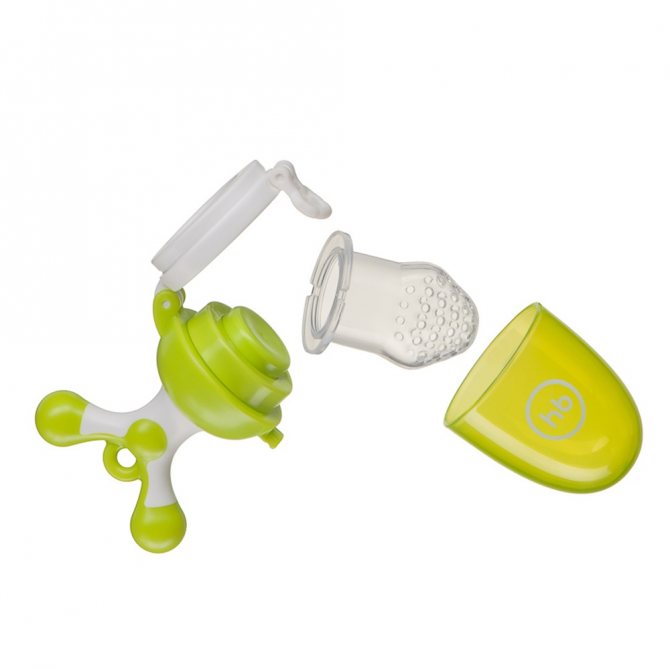
This is what a nibbler looks like
Attention! All products already introduced into the child’s diet can be combined.
Did you start complementary feeding earlier, around 4 months? According to the norms, this is quite acceptable (although it is undesirable; everything is left to the discretion of the parents). Then the little one eats the following foods:
- Poultry - chicken and turkey;
- Dairy products in the form of cottage cheese. Fermented milk mixture is allowed from six months.
- Prunes join the fruit.
There is more room for creativity here:
- Soups that contain all the introduced products become available. For example, chicken broth, it contains broccoli and pumpkin. Only this dish needs to be put through a blender.
- You can add fruit purees to porridge;
- For dinner, you can also combine meat or poultry and vegetables, serving them as a puree. By the way, this is how you can transfer your baby to a common table. Stew made from zucchini, cauliflower, broccoli and turkey can be eaten by both parents and their child.

The baby eats from the common table
- Desserts also become available to such a child. A baked apple (without cinnamon, of course), cottage cheese with banana puree - what's a substitute for sweets?
Important! You can’t add salt, much less pepper, to your baby’s food. Sugar is also extremely undesirable, at least for up to a year.
To summarize, babies who started feeding at different times should eat the following foods:
- Complementary feeding from 4 months: vegetable purees (broccoli, cauliflower, carrots, pumpkin, zucchini, potatoes), fruit purees (apple, pear, prunes, banana); meat purees (chicken, turkey, beef), yolk, cottage cheese without additives, dairy-free porridge (corn, buckwheat, rice), olive oil.
- Complementary feeding from 5 months: vegetable purees (broccoli, cauliflower, carrots, pumpkin, zucchini), fruit purees (apple, banana), meat purees (chicken), yolk, dairy-free porridge (corn, buckwheat, rice), olive oil.
- Complementary feeding from 6 months: vegetable purees (broccoli, cauliflower, zucchini), dairy-free porridge (corn, buckwheat), yolk, olive oil.
The rest (fermented milk products for children, cookies, juices, teas) is left variably at the discretion of the parents. No matter how the baby is fed, at six months at least half of the food he consumes should be milk or an adapted formula.
Mistakes when introducing complementary foods
Constipation in a baby while breastfeeding - what to do
Many young parents do not know how to properly begin to diversify their baby’s diet. They neglect the rules for creating menus for 6-month-old babies and make mistakes. They can be easily corrected if you study the recommendations of pediatricians. The main mistakes that parents make are:
- It's too early to try new foods. The child's body does not digest adult food very well, since it lacks the necessary digestive enzymes. As a result, the functioning of the digestive tract is disrupted and increased gas formation occurs.
- Start complementary feeding with fruit juices and purees. After your baby tries sweet purees and juices, it will be difficult to force him to eat bland vegetable purees. At 6 months of age, it is recommended to give preference to vegetables and dairy-free cereals.
- Mixing several components in one puree. This dish is suitable for a baby who has already tried all the components of the mixture. If it contains several new products for the child, then in the event of an allergy or adverse reaction it will be difficult to determine what exactly caused it.
- Feeding new foods in the evening. It is better for your baby to try new foods in the morning, so that there is time to observe his reaction. If you feed him at night, there is a risk of an attack of colic at night, and you may also not notice a rash on the skin that will go away by the morning.
Diet for a 6 month old baby during breastfeeding and diet
A 6-month-old child is fed according to a certain regimen, which consists of 5 meals a day. After the introduction of complementary foods, the amount of food consumed changes slightly. For a six-month-old baby, the optimal diet is:
- The first feeding is breast milk 200 ml.
- The second meal is 100 g of dairy-free porridge and 50 g of fruit puree, supplemented with breast milk.
- Third feeding - 150 g of vegetable puree and additional feeding with mother's milk.
- The fourth and fifth feedings consist of 200 ml of baby milk.
Table of the approximate diet of a 6 month old child per week
| Feeding time | Monday | Tuesday | Wednesday | Thursday | Friday | Saturday | Sunday |
| 6.00 | Breast milk 200 ml | Breast milk 200 ml | Breast milk 200 ml | Breast milk 200 ml | Breast milk 200 ml | Breast milk 200 ml | Breast milk 200 ml |
| 10.00 | Rice porridge 120 g. | Buckwheat porridge 120 g. | Oatmeal 120 g. | Rice porridge 120 g. | Buckwheat porridge 120 g. | Oatmeal 120 g. | Rice porridge 120 g. |
| 14.00 | Zucchini puree 150 g. | Pumpkin puree 150 g. | Cauliflower puree 150 g. | Broccoli puree 150 g. | Vegetable mixture 150 g. | Zucchini puree 150 g. | Pumpkin and cauliflower puree 150 g |
| 18.00 | Breast milk 200 ml | Breast milk 200 ml | Breast milk 200 ml | Breast milk 200 ml | Breast milk 200 ml | Breast milk 200 ml | Breast milk 200 ml |
| 22.00 | Breast milk 200 ml | Breast milk 200 ml | Breast milk 200 ml | Breast milk 200 ml | Breast milk 200 ml | Breast milk 200 ml | Breast milk 200 ml |
This diet is established by the end of the 6th month of development, at which point the baby is allowed to try dairy-free cereals, vegetable puree and fruit puree. Vegetables can be mixed together and alternated every day.

Child eats puree
After the introduction of complementary foods, the baby develops his own diet. Gradually, the amount of dairy-free porridge is increased to 150 g, vegetable puree - to 120 g. Every week the baby is allowed to try new foods to diversify his diet. Each vegetable and fruit has its own beneficial microelements necessary for the development of a child.
After each meal, the baby is fed with mother's milk. By the end of the 6th month, 2 meals are replaced with dairy-free porridge and vegetable puree. In between feedings, the baby is given 50-70 ml of fruit juice. By the beginning of the seventh month, the baby is fed with baby cookies dissolved in mother's milk. Cookies, dryers, and crackers are also introduced. They are given for snacking.
Feeding regimen for a 6 month old baby
You can organize nutrition for a breastfed baby at 6 months in the following way (European nutritionists and pediatricians adhere to this regimen):
- at 6 o’clock – breastfeeding;
- at 10 o’clock – fruit puree (30 g) and supplementary feeding with breast milk;
- at 14:00 – vegetable puree (150 g with vegetable oil) or porridge, freshly squeezed fruit juice (50 ml) or supplementary feeding with mother’s milk;
- at 18:00 – fruit puree (30 g) and mother’s milk;
- at 22:00 – breastfeeding.
For a bottle-fed baby, the recommended feeding regimen is:
- at 6 o’clock – adapted mixture (milk or fermented milk);
- at 10 o’clock – porridge with milk, butter and fruit puree;
- at 14:00 – soup (with meat or vegetable broth), vegetable puree with the addition of vegetable oil and half an yolk, freshly squeezed fruit juice;
- at 18:00 – milk mixture or cottage cheese, cookies;
- at 22:00 – kefir or an adapted mixture.
Taking into account the individual habits of the child, you can change the feeding time, but 4-hour intervals between feedings should be observed.
Recipes for homemade puree
Currently, many baby food manufacturers produce ready-made baby purees. They are bottled in jars ranging from 100 to 200 ml. During production, vegetables and fruits are processed into semi-liquid puree, then sterilized and poured into sterile containers. The labels indicate the composition and recommended age of consumption.
Important! When opening such cans, a click should be heard; if there is none, then such products are unsuitable for feeding a child.
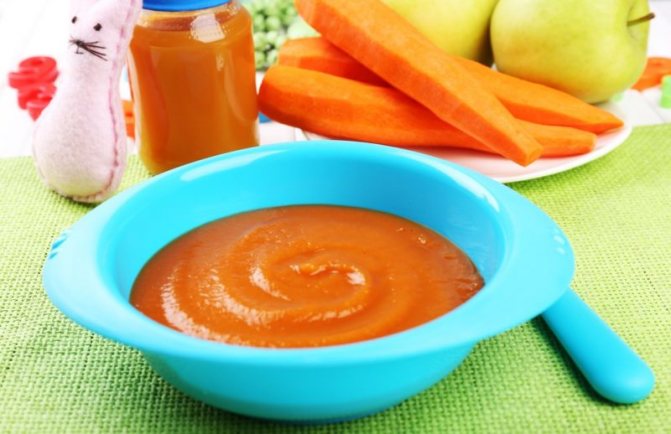
Baby puree
Many parents prefer to make their own vegetable puree for their children. The following recipes are suitable for a 6 month old baby:
- Zucchini puree. The vegetable is peeled and washed. Then cut into medium-sized pieces and boil in water without salt and sugar. Beat the boiled zucchini in a blender with a small amount of vegetable broth.
- Prune puree. Dried plums are poured with warm water, they should swell. The water is drained and new water is added. Cook over medium heat for 15 minutes. If the prunes had seeds, they are removed. The resulting mixture is whipped.
- Apple juice. A fresh apple is grated on a fine grater. The pulp is placed in cheesecloth and the juice is squeezed out.
- Baked apple. Fresh fruits are washed and the tops are cut off. Place on baking sheets and bake at 150°C.
- Dairy-free buckwheat. 1 tbsp. buckwheat is washed and dried. The beans are ground in a coffee grinder. Then add 100 ml of hot water and cook.
The beginning of the introduction of complementary foods is a crucial moment in the life of a child and his parents. For breastfeeding, the best age is 6 months. By this time, the baby can already sit, he is actively developing and is interested in adult foods. Complementary feeding begins with small portions, which are gradually increased to 150 g. A well-designed menu and diet will allow you to monitor the baby’s nutrition and avoid mistakes.
